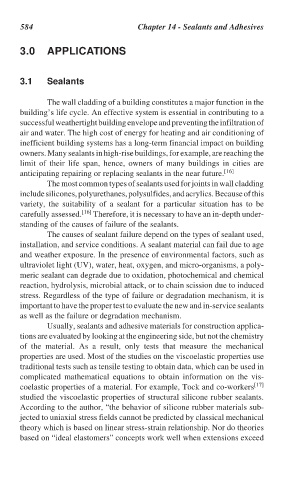Page 616 - Handbook of Thermal Analysis of Construction Materials
P. 616
584 Chapter 14 - Sealants and Adhesives
3.0 APPLICATIONS
3.1 Sealants
The wall cladding of a building constitutes a major function in the
building’s life cycle. An effective system is essential in contributing to a
successful weathertight building envelope and preventing the infiltration of
air and water. The high cost of energy for heating and air conditioning of
inefficient building systems has a long-term financial impact on building
owners. Many sealants in high-rise buildings, for example, are reaching the
limit of their life span, hence, owners of many buildings in cities are
anticipating repairing or replacing sealants in the near future. [16]
The most common types of sealants used for joints in wall cladding
include silicones, polyurethanes, polysulfides, and acrylics. Because of this
variety, the suitability of a sealant for a particular situation has to be
carefully assessed. [16] Therefore, it is necessary to have an in-depth under-
standing of the causes of failure of the sealants.
The causes of sealant failure depend on the types of sealant used,
installation, and service conditions. A sealant material can fail due to age
and weather exposure. In the presence of environmental factors, such as
ultraviolet light (UV), water, heat, oxygen, and micro-organisms, a poly-
meric sealant can degrade due to oxidation, photochemical and chemical
reaction, hydrolysis, microbial attack, or to chain scission due to induced
stress. Regardless of the type of failure or degradation mechanism, it is
important to have the proper test to evaluate the new and in-service sealants
as well as the failure or degradation mechanism.
Usually, sealants and adhesive materials for construction applica-
tions are evaluated by looking at the engineering side, but not the chemistry
of the material. As a result, only tests that measure the mechanical
properties are used. Most of the studies on the viscoelastic properties use
traditional tests such as tensile testing to obtain data, which can be used in
complicated mathematical equations to obtain information on the vis-
coelastic properties of a material. For example, Tock and co-workers [17]
studied the viscoelastic properties of structural silicone rubber sealants.
According to the author, “the behavior of silicone rubber materials sub-
jected to uniaxial stress fields cannot be predicted by classical mechanical
theory which is based on linear stress-strain relationship. Nor do theories
based on “ideal elastomers” concepts work well when extensions exceed

